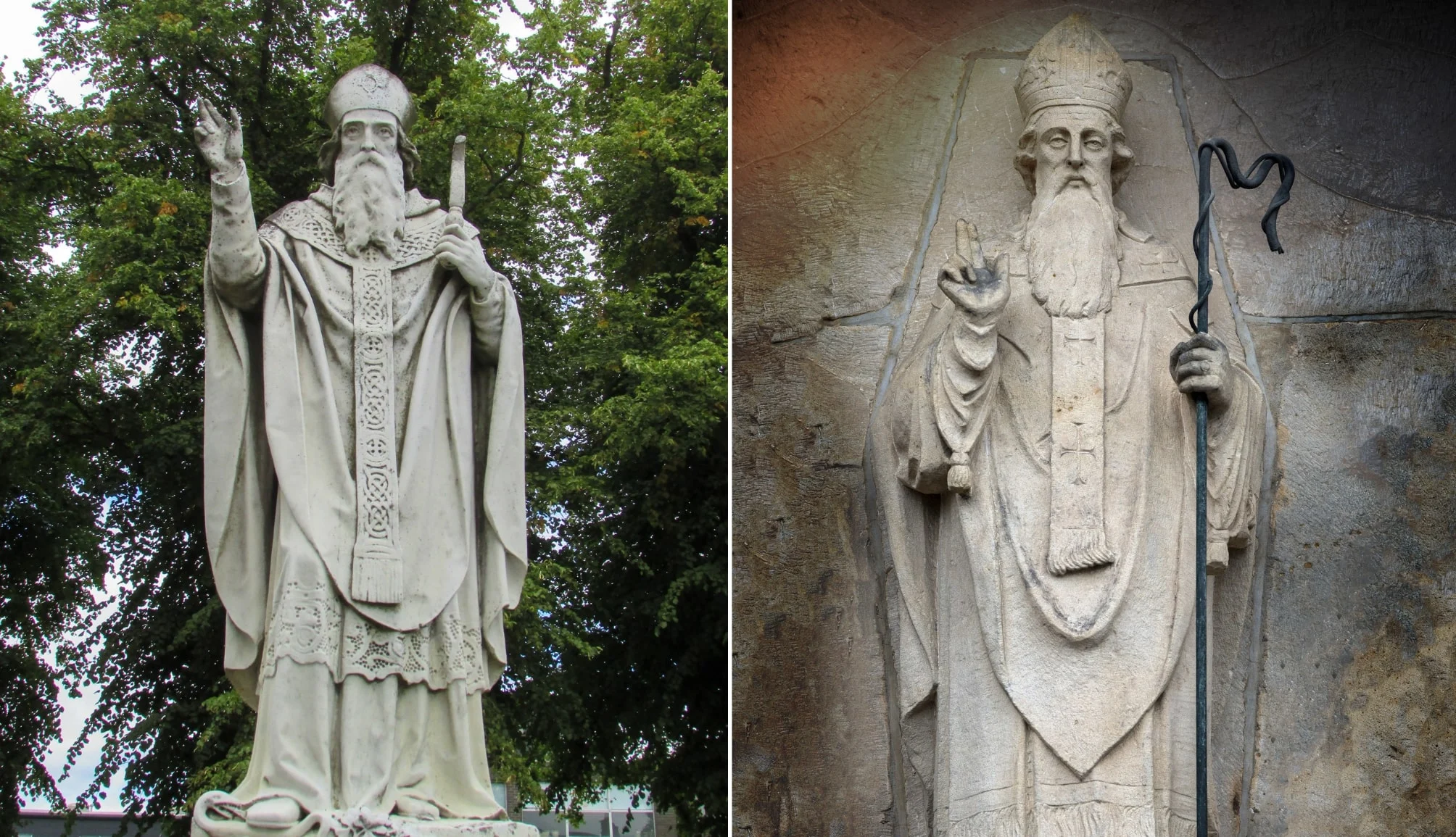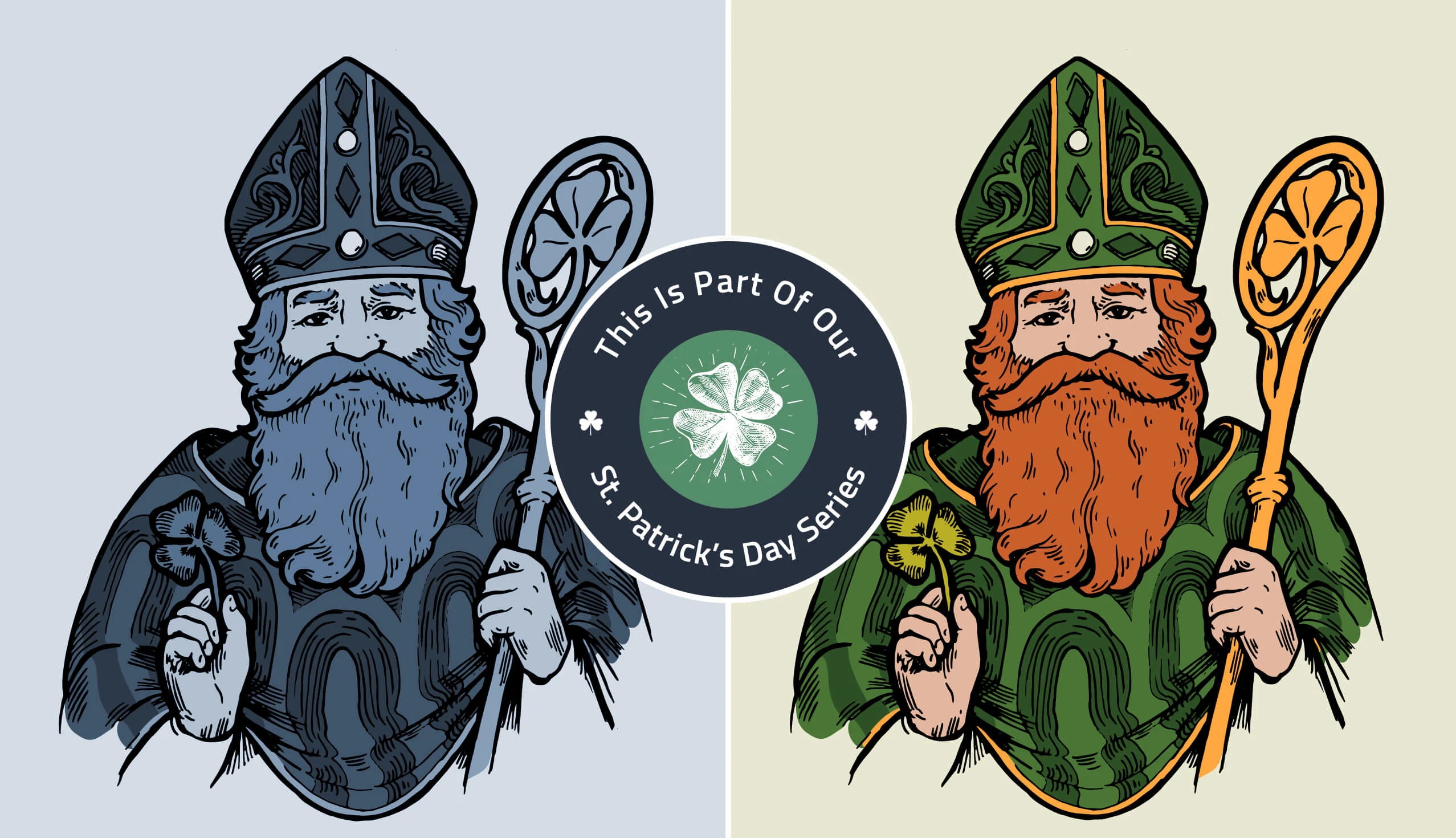We get asked what was the original color associated with St. Patrick a fair bit in the lead up to the ‘big day’.
The answer is blue!
It’s one of the lesser-known St. Patrick’s Day facts with many associating green with Ireland’s Patron Saint.
Below, you’ll discover why blue was the original colour of St. Patrick and how it’s now green!
Some quick need-to-knows about the original color of St. Patrick

To save you scrolling, you’ll find some speedy need-to-knows about the first color associated with St. Patrick’s Day below:
1. Yep, it all began with blue, not green
Although people wear green on St. Patrick’s Day, early depictions of St. Patrick show him clothed in fine blue robes. In fact, in Saul Church, which is on the site where St. Patrick died, he is shown wearing blue robes.
2. The color blue has great significance
From Ireland’s coat of arms showing an Irish harp set against an Azure blue to the sovereignty of Ireland being depicted by a woman showing wearing a blue robe, this color runs deep in Ireland’s past.
3. Where green comes into it
It’s believed that St. Patrick became associated with the color green through his use of the shamrock. He travelled around Ireland spreading the word of God and used the shamrock in his teachings. More on this below.
Why blue was the original colour of St. Patrick

Photos via Shutterstock
So, why was the original color of St. Patrick blue? It’s a confusing enough story as it isn’t as simple as ‘He used to only wear blue’.
I’m going to start by explaining why we can be confident that blue was his color before going on to explain the significance of the color blue in Ireland.
St. Patrick is shown wearing blue at Saul Church
It’s this that confirms it, for me. If you’re not familiar with Saul Church, it is a sacred site in County Down which is said to be the earliest place of Christian worship in Ireland.
It was founded by Ireland’s Patron Saint in 432 AD and it was here that he died in 461 AD. The church boasts some gorgeous stained glass windows.
In the ones that show St. Patrick, he is dressed in blue. We can be reasonably confident that, if a place that has such deep links to St. Patrick shows him in blue, they do so for a reason.
The importance of blue in ‘early’ Ireland
Early Irish texts often mention ‘Gormfhlaith’. It’s believed that ‘Gormfhlaith’ refers to a number of queens that were connected to dynastic politics.
The word ‘Gormfhlaith’ is a combination of two Irish words – ‘Gorm’ which means ‘Blue’ and ‘Flaith’ which means ‘Sovereign’.
In legends from early Irish myths Flaitheas Éireann, which was the sovereignty of Ireland, was depicted by a woman showing wearing a blue robe.
Henry VIII and English rule in Ireland
Henry VIII assumed the throne in April 1509. This was after a staggering 300+ years of English rule in Ireland.
In order to continue English dominance, he declared himself as the ‘King of Ireland’. In doing so, he made Ireland part of England and gave our little island a dedicated coat of arms.
The coat of arms show an Irish harp set against an Azure blue.
The Order of St. Patrick and early depictions
The Order of St. Patrick is a now inactive order of Knighthood that was created by King George III in 1783.
The orders badge uses a color known as St. Patrick’s Blue. There are also numerous depictions of St. Patrick wearing blue in artwork from as early as the 13th century.
Where green came from
It’s widely accepted that St. Patrick used the shamrock while trying to spread the word of God around Ireland.
It’s believed that he used the three ‘arms’ of the shamrock to depict the Holy Trinity – each ‘arm’ represented either the Father, the Son or the Holy Spirit.
FAQs about the original colour of St. Patrick
We’ve had a lot of questions over the years asking about everything from ‘What is the significance of blue?’ to ‘Why do some people wear orange?’.
In the section below, we’ve popped in the most FAQs that we’ve received. If you have a question that we haven’t tackled, ask away in the comments section below. Here are some related reads you should find interesting:
- 73 Funny St. Patrick’s Day Jokes For Adults And Kids
- The Best Irish Songs And The Best Irish Films Of All Time For Paddy’s Day
- 8 Ways That We Celebrate St. Patrick’s Day In Ireland
- The Most Notable St. Patrick’s Day Traditions In Ireland
- 17 Tasty St. Patrick’s Day Cocktails To Whip Up At Home
- How To Say Happy St. Patrick’s Day In Irish
- 5 St. Patrick’s Day Prayers And Blessings For 2024
- 17 Surprising Fact’s About St. Patrick’ Day
- 33 Interesting Facts About Ireland
Why is blue associated with St. Patrick?
Blue was the original color associated with St. Patrick. In the place where he passed away in County Down, he is shown wearing blue on stained glass windows.
Why did St. Patrick’s color change from blue to green?
There’s many thoughts behind this. Our favourite is that, when St. Patrick tried to convey the word of God to people in Ireland he used a shamrock to depict the Holy Trinity. He then became associated with the green of the shamrock.

